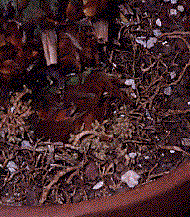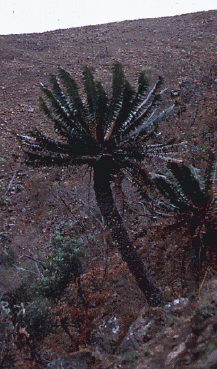







Interactions with other living things, or biotic interactions, play an important role in the biology of cycads, particularly in pollination, seed dispersal, and the acquiring of nitrogen nutrients.
 Cycad pollination was long thought to be a chance event, effected only by
the wind. This was especially troublesome for understanding the success of
understory cycads in tropical forests, where there is little wind, and where
pollen studies have shown that there is almost no cycad pollen in the air.
More recent investigations have suggested that
beetles,
especially weevils, and small
bees may make a more
important contribution to the transfer of pollen. Studies have also shown
that some cycads at least will produce heat or odors to attract these animal vectors.
Cycad pollination was long thought to be a chance event, effected only by
the wind. This was especially troublesome for understanding the success of
understory cycads in tropical forests, where there is little wind, and where
pollen studies have shown that there is almost no cycad pollen in the air.
More recent investigations have suggested that
beetles,
especially weevils, and small
bees may make a more
important contribution to the transfer of pollen. Studies have also shown
that some cycads at least will produce heat or odors to attract these animal vectors.
The seeds of cycads are quite large, and are often brightly colored; red, purple, and yellow seeds are common. These colorful seeds are displayed as the cone matures and the seed-bearing leaves separate from each other; the colors attract birds and a variety of mammals which disperse the seeds.
One of the more novel biotic interactions among plants is an association with photosynthetic bacteria, such as Anabaena. In cycads, the cyanobacteria are sheltered in specially modified roots which have the appearance of coral, and so are called coralloid roots, as seen above at left. These roots grow up out of the soil, rather than down into it, and are thus exposed to light which the cyanobacteria need. In return for providing this stable habitat, the cycad acquires nitrogen nutrients from the bacteria.

Though they are often among the larger plants in their environment, cycads are no longer abundant or dominant components of the world flora. Today's cycads are found on every continent except Europe and Antarctica, but are restricted to a limited number of areas in the tropics and subtropics.
Cycads grow in a number of different habitats. Species may be found as components of the forest understory in both rainforests and seasonally dry forests, or occasionally as members of the forest canopy. Other cycads grow in loose stands in grasslands, forming a kind of savanna. Exceptional among the cycads are species of Encephalartos, one of which is visible at right, which grow in eastern Africa at very high elevation. Here they must contend with extremely xeric conditions -- low rainfall, harsh winds, and dry soil -- and must deal with frost and heavy snow at times as well.
Many cycads may be grown outdoors in California and the southern United States, but they cannot seem to tolerate the less equable climate in other parts of the nation.
Today only a handful of cycads still exist, and many are facing possible extinction in the wild (such as Microcycas in western Cuba). Cycads are in danger of becoming extinct both because they live in endangered habitats such as tropical forests, and because they grow so slowly and reproduce so infrequently.
Several species are already extinct in the wild. Many more are under threat from habitat destruction, and pressure from unscrupulous collectors. However, because of their large attractive leaves, many cycads have found a home in public and private gardens around the world. Breeding programs at several institutions have been undertaken to preserve the various species, but this is made difficult by the necessity of maintaining genetic variation present in natural populations. To protect natural populations, five genera are now covered by international law, prohibitting trade of seeds collected in the wild.
All this effort may not be enough to save the cycads from extinction. Fairchild Botanical Garden in Florida maintained one of the world's most comprehensive collections of living cycads, including many that are endangered in the wild. The Garden was severely hit by hurricane Andrew in 1992 and most of the non-native plants, including most cycads, were severely damaged or killed. A botanical SWAT team from Missouri Botanical Garden was helicoptered in to Fairchild as the storm clouds were clearing. Their goal was to save as many of the plants as possible, and to preserve the rest for future study.


